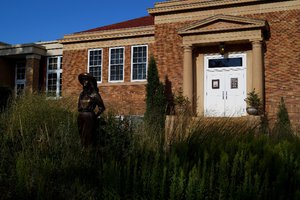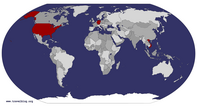Advertisement
Published: September 21st 2014

 MARI SANDOZ
MARI SANDOZ
Mari has her own museum on the campus of Chadron State College. This statue is in front of it. One of Mari's eyes was all skewumpus from getting snow blind trying to pull some cattle out of a snow drift when she was a girl.Had lunch in a silly little place called Harrison, NE. The only eating place in town was in the Longhorn Saloon. The walls are festooned with the skins of about 20 large rattlesnakes. I ordered a burger, fries, and a diet Squirt. The Longhorn Saloon may be the only place in America where you can still get Diet Squirt. The burger was pretty good, but of course fresh vegetables are unheard of in Harrison so it just came with some sour pickles. A few miles off to the north of Harrison is the Warbonnet Creek Battleground. It is up a pretty bad road, and is hard to find and a bit difficult to access by foot right after you just had lunch with 20 rattlers. When I left there the “check engine” light blinked on in my Jeep. I will check the fluid levels tomorrow when I gas up, but probably won’t be able to get the engine checked until I find a bigger town than Lusk. Place is full of Mormon chiselers; the motel room is $118. I had a chef salad for supper at a place called the Outpost and it was served with rotten

 BORDEAUX
BORDEAUX
The trading post was rebuilt exactly on its original site. It is on the grounds of the Fur Trade Museum. The museum holds an absolutely world class collection of artifacts. turkey meat. The iced tea was not bad, but they did not offer a refill. There are a bunch of old people having a reunion at this motel. They were all outside getting drunk when I got here. Hope they don’t wander off in the dark and get lost; they might step on a large rattlesnake.
MARI SANDOZ Her folks both came from Switzerland but, no, she didn’t have anything to do with the laboratory that invented LSD. Mari was born in the sand hills of Nebraska and was an ordinary hard working farm girl graduating from 8
th grade at the age of 17. Within a year she married a neighbor named Wray Macumber, but Wray wanted her to milk cows and hoe the garden. Mari preferred to write stories. The sad marriage only lasted about five years and produced no children. After the divorce she moved to Lincoln and held a variety of starvation jobs for the next 16 years that enabled her to write all of the stories she wanted, but no publishers were interested in hearing from any Nebraska farm girls. Everything she wrote was firmly rejected. In 1928 her dad took to his death

 CRAZY HORSE
CRAZY HORSE
Crazy Horse was killed where the stone monument sits. He was killed by Indian police who jabbed him through the liver as he was resisting getting locked up in the guardhouse. Both the army and the Treaty Indians feared him as a trouble maker. bed, but before he went up the flume he requested that she write his life story. The resulting book was called (and you guessed it)
Old Jules. Of course it was rejected. In 1933 she was in poor health and malnourished and had to go live with her mom awhile. Before she left Lincoln she hauled 70 0f her manuscripts out in the yard and burned them in a wash tub. By January of 1934 she had returned to Lincoln and got a job with the Nebraska Historical Society as associate editor of
Nebraska History Magazine. Lo and behold in 1935 the story about her dad won a contest in non-fiction sponsored by Atlantic Press and it got published. She was finally off and running as a writer. The next book she wrote was called
Slogum House. It was a gritty story about a ruthless Nebraska family who ran a brothel. The story was published in 1937 and during WWII was banned in the military for being a bit too gritty. As a result its popularity soared across the country but in Nebraska it was considered to be an attack on the character and morals of Nebraskans. The next book,

 WARBONNET HILL
WARBONNET HILL
The soldiers hid behind this hill to spring their ambush. I was too scared of rattlesnakes and ticks to cross the grasslands there. The Forest Circus controls this land and they have it closed to vehicles.published in 1939, landed her in the hot seat around Lincoln. It was called
Capital City and was considered to be an assault on the political morality of the state. She moved to Denver after getting a high pile of hate mail. Denver had better research facilities anyway. In 1942 she published what many readers consider to be her best work. It was biography of Crazy Horse written from the perspective of the Lakota and using their idiomatic speech and cultural patterns. As her popularity increased she moved to New York City to have better access to publishers. One of her books,
Cheyenne Autumn, was made into a pretty good movie. She continued writing until 1964 and passed away in 1966 from bone cancer. A most interesting woman but she liked to wear silly hats.
“BEAR” BORDEAUX Our fur grounds were always thick as lice with French Canadians. Most of them worked in some capacity or other for the American Fur Company out of Fort Union at the confluence of the Yellowstone and Missouri Rivers. In 1837 the American Fur Company decided to expand their operational base among the Sioux. Frederick Laboue, known as “Grey Eyes” to the

 YELLOWHAND
YELLOWHAND
the monument marks the spot where Yellowhand was killed. Once Buffalo Bill made it up to Deadwood he quit the army again. Sioux, was selected to establish the new posts needed. He had already purchased Fort Laramie from the American, William Sublette, and ordered a new post built in northeast Nebraska to be managed by a Missouri Frenchman named James Bordeaux, who was known to the Sioux as “Bear”. Bordeaux was married to two Brule sisters whose brother was Swift Bear, chief of the Corn Band. In 1849 the U S Army purchased Fort Laramie from American Fur to protect travel along the immigrant trails up the North Platte River. The fur company lost their trading post there and Bear Bordeaux soon built another one nearby. During August of 1854 a Mormon caravan was passing through Fort Laramie and had lost a footsore cow. A Sioux named High Forehead saw that the cow was in such poor condition it could not be saved so he killed it and it made a fine supper for his friends. When the soldiers came down the next day to recover the cow they handled the situation so poorly that all 30 of them were massacred. That incident took place in a meadow within hollering distance of Bear’s new post. Had he been called upon to act as interpreter, in place of the drunken lout who came with the soldiers, the massacre would have been avoided. Bear did serve as an interpreter at the Fort Laramie Treaty of 1868 it was a peace treaty that ended Red Cloud’s War. It was the only time that the army had been defeated in a war within our own national boundaries. We made huge concessions to Red Cloud if he would just stop kicking our ass every time we turned around. All during this time Bear’s son Louis operated the post in Nebraska on Bordeaux Creek. After the War Between the States ended Indian trade in the Northern Plains kind of fell apart. The Sioux wanted guns and ammo instead of pots and pans or even whiskey. They were resisting government attempts to force them off of land that they now clearly owned by treaty. In 1872 Bear returned to Missouri to become a government contractor to the army. He died of pneumonia in 1878 at the age of 64. Soon as Bear left Nebraska the post on Bordeaux Creek was taken over by another French Canadian named Francis Boucher, or “Bushy” to the Sioux. Bushy was married to Spotted Tail’s daughter. Spotted Tail was a big cheese among the Brule and Bushy was pleased to trade guns and ammo to him. Those were the guns used to defeat Custer at Little Big Horn and Crook on the Rosebud. In August of 1876 the army finally put him out of business. The Bordeaux Trading Post fell into ruination soon afterward.
FORT ROBINSON In 1873 Red Cloud’s agency was closed near Fort Laramie and moved to Pine Ridge on the White River. Fort Robinson was built in 1874 to provide protection and support to Red Cloud. The army was still scared to death of him the post was not abandoned until 1947. On May 6, 1877 Crazy Horse surrendered here, and on September 8 he was killed while resisting imprisonment here. Dull Knife and his merry band busted loose from their confinement in Oklahoma during the summer of 1878 and were finally rounded up and imprisoned at Fort Robinson. In January of 1879 they broke out of captivity again and rushed off into the frozen hinterlands where the army killed most of them who had not already frozen to death. The civilian town that sprang up nearby was called Crawford. It was named for Captain Emmett Crawford who had been posted here before reassignment to the Apache Wars in Arizona. Crawford was killed in a skirmish with Mexican soldiers while chasing down Geronimo in the Sierra Madre Mountains. After WWI the post became a quartermaster remount station for what horses and mules the army still needed. During WWII it became a prison camp for captured Nazis and was where the K9 dogs were trained. It could not have been much fun for those prisoners.
WARBONNET Buffalo Bill Cody offered his services as an army scout at Fort Robinson soon as he heard about Custer’s destruction at Little Big Horn. Soon as word of the massacre reached the Pine Ridge Agency a few of the Treaty Indians decided to scamper off and join the hostiles. Cody led a detachment to head them off. The soldiers found a couple of low hills to hunker down behind where they could be hidden but still have a vantage point to watch for the approach of the fleeing Indians. Sure enough they spotted the Indians coming and were getting to spring an ambush when Cody spotted an advance scout who had discovered the soldier position and was speeding back up a wash to warn his pals. Cody blasted him off his pony and the others made back for the safety of Pine Ridge. The dead Indian was recognized as Yellowhand, so known because he had the scalp of a blond woman on his war lance. He was the first Indian killed in retribution for Custer’s bloody defeat. The soldiers then continued on up to join General Crook at Deadwood.
Advertisement
Tot: 0.075s; Tpl: 0.01s; cc: 15; qc: 29; dbt: 0.0276s; 1; m:domysql w:travelblog (10.17.0.13); sld: 1;
; mem: 1.1mb










